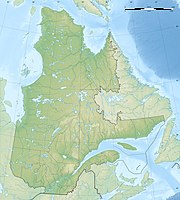Parc national du Bic
|
Parc national du Bic
|
||
|
Coastal landscape in the park area |
||
| location | Quebec , Canada | |
| surface | 33.2 km² | |
| WDPA ID | 23124 | |
| Geographical location | 48 ° 21 ' N , 68 ° 47' W | |
|
|
||
| Setup date | 1984 | |
| administration | Sépaq | |
The Parc national du Bic is one of the currently 27 national parks in the Canadian province of Québec . There, a parc national corresponds to what corresponds to a provincial park in the other provinces . The park is operated by Sépaq ( French Société des établissements de plein air du Québec or English Society of outdoor recreation establishments of Quebec ).
The task of the park, which was set up in 1984 in the south of the province on the south bank of the Saint Lawrence River and only 33.2 km² in size, is to provide a refuge for harbor seals and gray seals and other residents of the Saint Lawrence River, and to increase biodiversity to protect the adjacent mainland, which represents the southern edge of the boreal forests in a transition zone. Almost half of the protected area comprises marine areas and salt marshes, plus the adjacent hilly landscape. The highest point in the park is the 346 m high Pic Champlain . Erosion research has been carried out in the park area since 2009.
history
Human traces can be found in the park area up to around 7000 BC Trace back to BC. From 1976 to 1978, 30 sites were documented in the park area within a few weeks. Three sites can be assigned to the late Archaic period.
Nothing is known about the area from the time of French colonial rule, it only fell to one of the feudal lords with the British. A pilot station existed on the Île du Bic until 1905, but it was moved to Pointe-au-Père . Until then, a little agriculture was done on the St. Lawrence River. Since the end of the 19th century, weekend houses have been built on the river, some of which have survived. Preparations for the establishment of a protected area began in the early 1970s, and the park was opened in 1984.
Flora and fauna
The park is located on the southern border of the boreal forests. Therefore this transitional vegetation was a weighty argument for the establishment of the park, although logging and agricultural use had already changed the fauna. The abandoned fields offer the opportunity to investigate the return of the original species to the fallow land.
The white-tailed deer population declined during the 1990s , but has since recovered. In 2005/06 it was estimated at 113 ± 25 animals. Seals and gray seals are the most noticeable inhabitants of the coastal fringe, but it is also frequented by whales and dolphins.
Since Québec joined the program to protect birds of prey and reintroduce certain species in 1980, populations, such as the peregrine falcon , have been recovering . They had previously collapsed completely from the use of DDT . 15 falcons were released.
The collection of sand clams should go back several millennia. Today, however, they are often contaminated, for example by heavy metals, so that their catch is prohibited in many places. This is due, among other things, to industrial activities, as a result of which the Ha! Ha! collect the poisons.
Beach sea urchins ( Psammechinus miliaris ) were found in 15 places in the park in 1984. On the coastline of the park there is a small population of the Atlantic salmon, which in 1990 consisted of 25, perhaps 40 animals.
Numerous species of reptiles and amphibians live in the park. Until 2010: the forest frog , then the mink frog in English , the frog Rana septentrionalis known in French as grenouille verte , the leopard frog , Pseudacris crucifer and the Bufo americanus , (Eurycea bislineata) , Plethodon cinereus , Ambystoma maculatum , which also consists of the family of cross-toothed newts comes like the blue-spotted cross-toothed newt . Added pseudonaja as Storeria occipitomaculata , collar Natter ( Diadophis punctatus ) or the common garter snake .
Inventories for small mammals, salamanders, snakes, etc. should be created.
literature
- The research scientifique dans les Parcs nationaux québécois. Priorités et potentiels de recherche , published by Parcs Québec and Sépaq, undated, pp. 36–48.
- Claude Lavoie: La Flore du parc national du Bic - Évolution historique et proposition d'aménagement , Center de recherche en aménagement et développement et herbier Louis-Marie. Université Laval 2006.
See also
Web links
Individual evidence
- ↑ Pierre Dumais: Le Bic, images de 9000 ans d'occupation amér Indienne , Ministère des Affaires culturelles, direction générale du patrimoine, direction de l'Est du Québec et direction des communications, dossier 64, 1988.
- ^ Pierre Dumais, G. Rousseau: Trois sites paleoindiens sur la côte sud de l'estuaire du St-Laurent , in: Recherches amér Indiennes au Québec XV, 1-2 (1985) 135-150.
- ^ B. Blais: Suivi des nids de Faucon pèlerin dans le sud du Québec. Report soumis à la Société de la faune et des parcs et au Service canadien de la faune, été 2000 , 2000.




